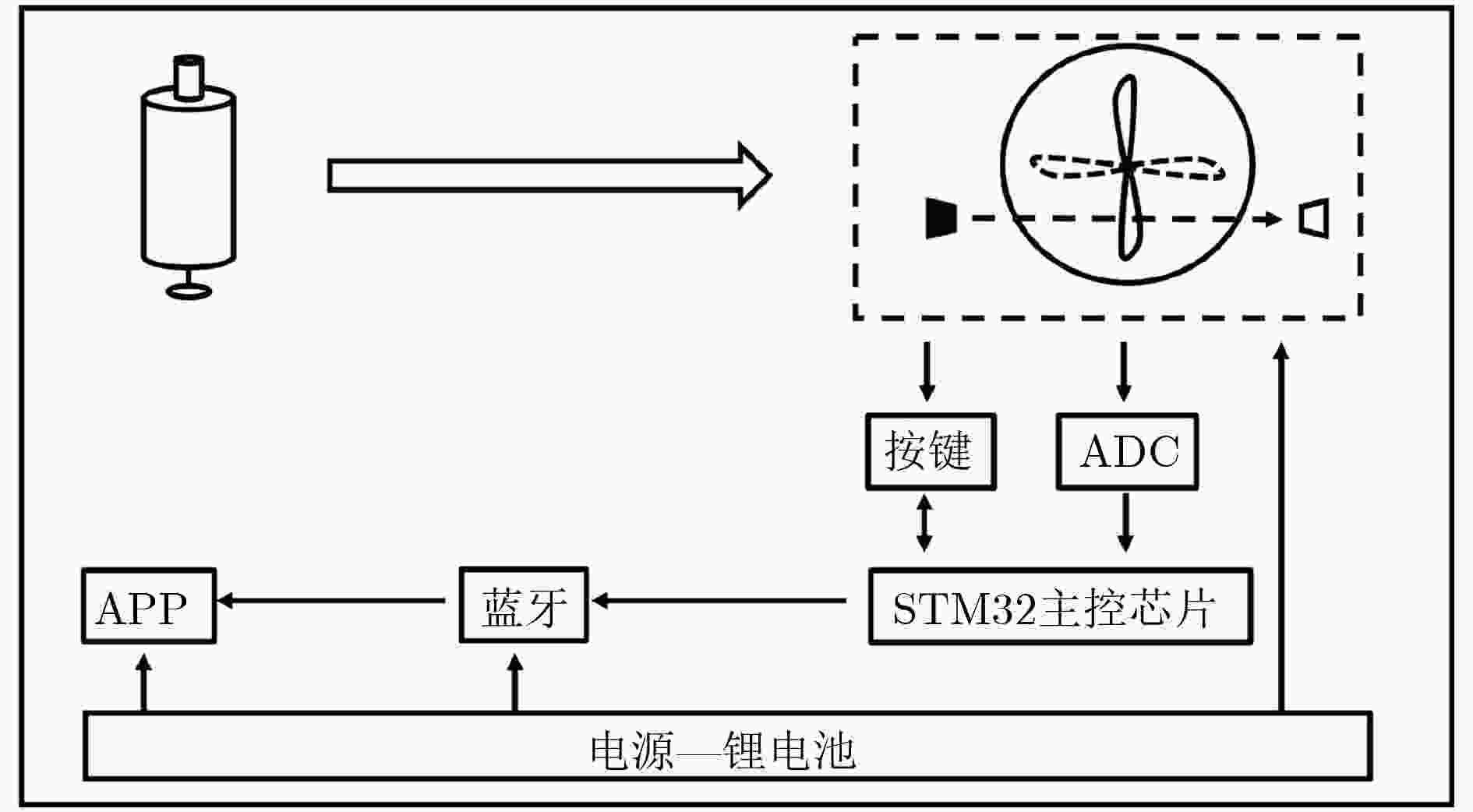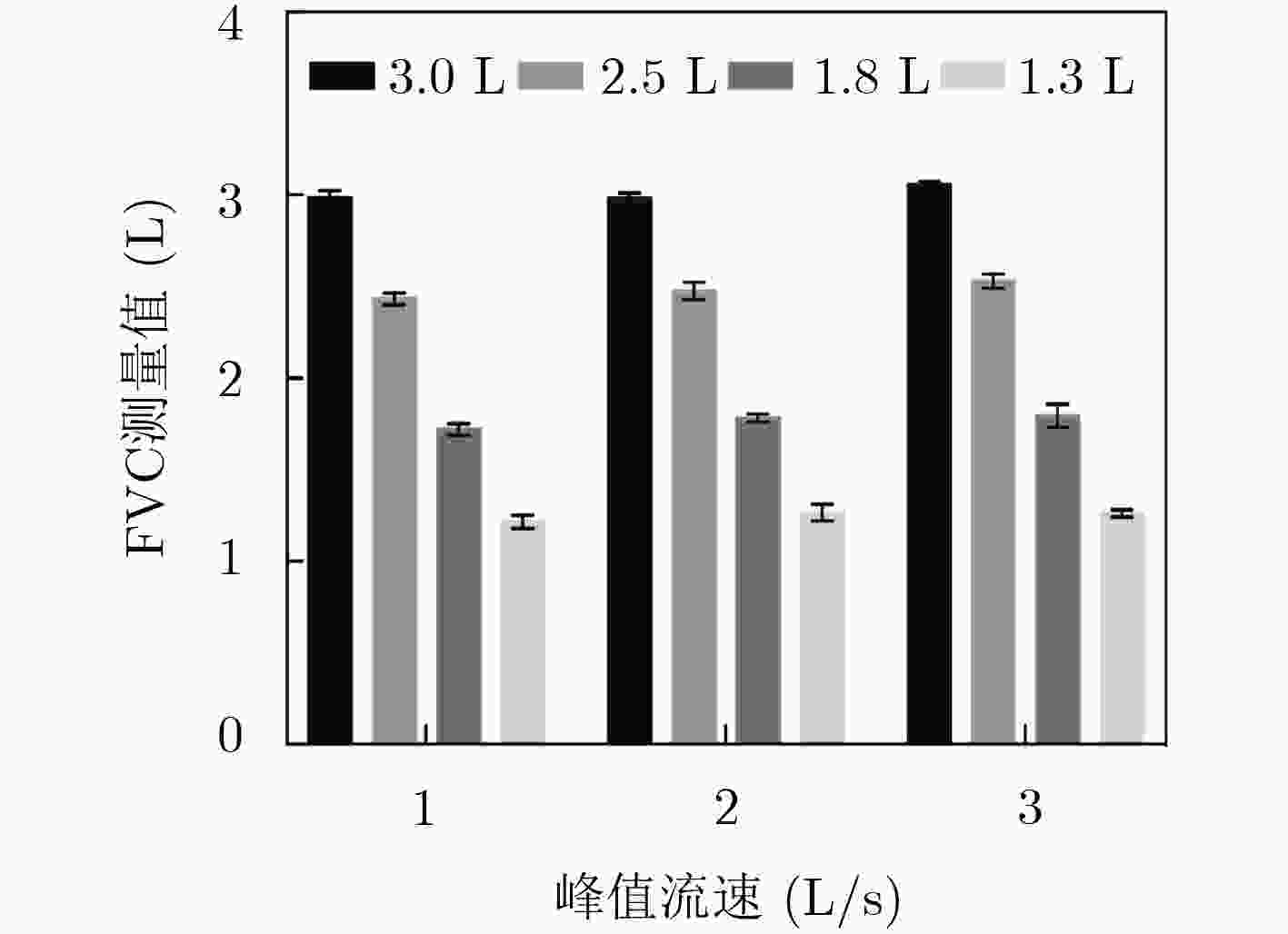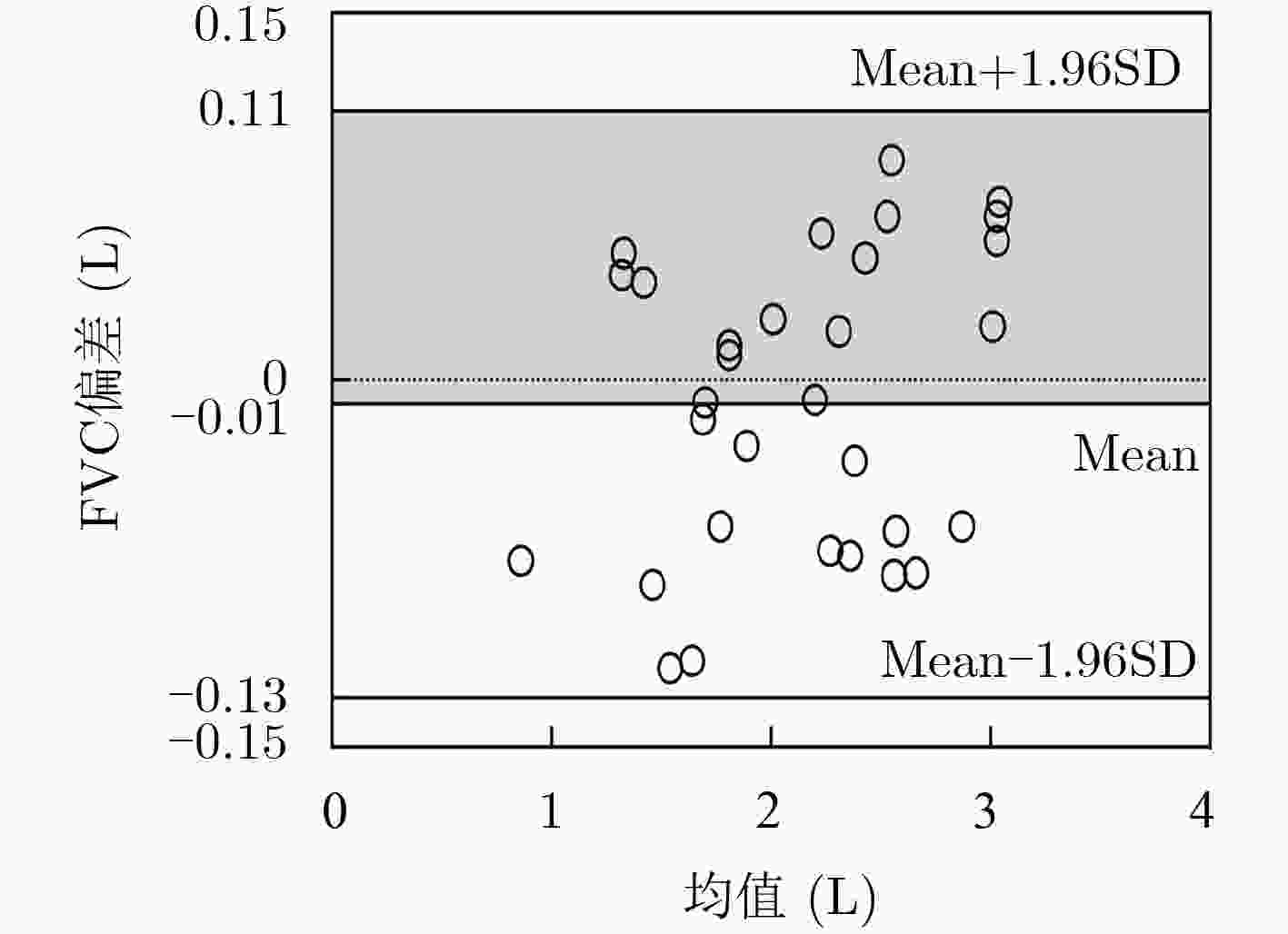Calculation of Forced Vital Capacity Based on Turbine Air Flow Sensor
-
摘要: 涡轮式气体流量传感器在用力肺功能测试中用于记录人体呼气信号,由于旋转惯性,对于相同用力呼气容量(FVC)值,测量结果因呼出气体流量而异,且差异值通常不可接受。针对该问题,该文通过在传统稳态涡轮流量计算模型的基础上引入速度惩罚项,构建一种FVC速度惩罚模型,与此同时,提出使用过幅降采样涡轮旋转周数算法,二者结合,提高了FVC测试结果的可接受性。利用国际通用的标准3 L定标桶,模拟真实用力肺功能测试过程,对算法的有效性进行验证。实验结果表明:所提方法能够有效降低前述差异,在一定程度上满足美国胸科协会(ATS)和欧洲呼吸学会(ERS)所提出的用力肺功能测试可接受标准和准确度要求。Abstract: Currently, the turbine air flow sensors are widely used to record the human exhalation signals in spirometry, but test results vary due to different expiratory flow for the same Forced Vital Capacity(FVC) measurements, and the differences are usually not in an acceptable range. To address this issue, a FVC velocity penalty model is proposed by introducing speed penalty items to the traditional mathematical model of turbine. Moreover, an over-amplitude drop sampling approach is used to calculate the rotations of the turbine due to the needs for the velocity penalty model to be able to accurately obtain the number of turbine rotations. The performance of the proposed approach is evaluated by using a syringe dispenser of 3L capacity, and results demonstrate that it can reduce the differences and meet the acceptable and accuracy criteria of the American Thoracic Society(ATS) and the European Respiratory Society(ERS) to some extent.
-
表 1 10次随机气体推进实验对涡轮旋转周数测量值与真实值对比
实验(次) 1 2 3 4 5 6 7 8 9 10 真实值(周) 256 150 178 358 321 89 205 316 56 124 测量值(周) 253 148 172 354 316 87 204 310 56 122 -
VAN DER HEIJDEN M, LUCAS P J F, LIJNSE B, et al. An autonomous mobile system for the management of COPD[J]. Journal of Biomedical Informatics, 2013, 46(3): 458–469. doi: 10.1016/j.jbi.2013.03.003 POLVERINO F and CELLI B. The challenge of controlling the COPD epidemic: Unmet needs[J]. The American Journal of Medicine, 2018, 131(9 Suppl 1): 1–6. WANG Chenshuo, CHEN Xianxiang, ZHAO Rongjian, et al. Predicting Forced Vital Capacity (FVC) using Support Vector Regression (SVR)[J]. Physiological Measurement, 2019, 40(2): 025010. doi: 10.1088/1361-6579/ab031c World Health Organization 2018. Chronic Obstructive Pulmonary Disease (COPD)[EB/OL]. https://www.who.int/respiratory/copd/en/, 2018. SHARAN R V, ABEYRATNE U R, SWARNKAR V R, et al. Predicting spirometry readings using cough sound features and regression[J]. Physiological Measurement, 2018, 39(9): 095001. doi: 10.1088/1361-6579/aad948 ZHONG Nanshan, WANG Chen, YAO Wanzhen, et al. Prevalence of chronic obstructive pulmonary disease in china: A large, population-based survey[J]. American Journal of Respiratory and Critical Care Medicine, 2007, 176(8): 753–760. doi: 10.1164/rccm.200612-1749OC JOHNSON J D and THEURER W M. A stepwise approach to the interpretation of pulmonary function tests[J]. American Family Physician, 2014, 89(5): 359–366. MILLER M R, HANKINSON J, BRUSASCO V, et al. Standardisation of spirometry[J]. European Respiratory Journal, 2005, 26(2): 319–338. doi: 10.1183/09031936.05.00034805 WAN E S, FORTIS S, REGAN E A, et al. Longitudinal phenotypes and mortality in preserved ratio impaired spirometry in the COPDgene study[J]. American Journal of Respiratory and Critical Care Medicine, 2018, 198(11): 1397–1405. doi: 10.1164/rccm.201804-0663OC RAO M V A, KAUSTHUBHA N K, YADAV S, et al. Automatic prediction of spirometry readings from cough and wheeze for monitoring of asthma severity[C]. The 25th European Signal Processing Conference, Kos, Greece, 2017: 41–45. SAHIN D, ÜBEYLI E D, ILBAY G, et al. Diagnosis of airway obstruction or restrictive spirometric patterns by multiclass support vector machines[J]. Journal of Medical Systems, 2010, 34(5): 967–973. doi: 10.1007/s10916-009-9312-7 何子军. 呼气信号分析方法及其在肺功能检查中的应用研究[D]. [博士论文], 中国科学技术大学, 2014: 17–22.HE Zijun. The method for analyzing expiratory signals and its application in pulmonary function testing[D]. [Ph.D. dissertation], University of Science and Technology of China, 2014: 17–22. CHEN Xiaoying, WANG Na, CHEN Yue, et al. Costs of chronic obstructive pulmonary disease in urban areas of China: A cross-sectional study in four cities[J]. International Journal of Chronic Obstructive Pulmonary Disease, 2016, 11(1): 2625–2632. LOU P, ZHU Yanan, CHEN Peipei, et al. Vulnerability, beliefs, treatments and economic burden of chronic obstructive pulmonary disease in rural areas in China: A cross-sectional study[J]. BMC Public Health, 2012, 12: 287. doi: 10.1186/1471-2458-12-287 BOSHNYAK L L, BYZOV L N, KAZNACHEEV B A, et al. Calibration of turbo-tachometric flowmeters[J]. Measurement Techniques, 1962, 5(7): 592–596. doi: 10.1007/BF00989035 LOPATA V, POPOV A, ELSHABBAH M, et al. Dynamic errors of forced expiration measurements by spirometers[C]. The 35th IEEE International Conference on Electronics and Nanotechnology, Kiev, Ukraine, 2015: 406–408. SOKOL Y I, TOMASHEVSKY R S, and KOLISNYK K V. Turbine spirometers metrological support[C]. 2016 International Conference on Electronics and Information Technology, Odessa, Ukraine, 2016: 1–4. 赵荣建, 周旺, 汤敏芳, 等. 四线涡轮式慢阻肺健康监护系统研究[J]. 电子与信息学报, 2019, 41(2): 469–476.ZHAO Rongjian, ZHOU Wang, TANG Minfang, et al. Research of chronic obstructive pulmonary disease monitoring system based on four-line turbine-type[J]. Journal of Electronics &Information Technology, 2019, 41(2): 469–476. 文红燕. 涡轮流量计在线监测系统的研究[D]. [硕士论文], 中国计量大学, 2016: 8–14.WEN Hongyan. Research on the online monitoring system of turbine flow meter[D]. [Master dissertation], China Jiliang University, 2016: 8–14. -






 下载:
下载:







 下载:
下载:
